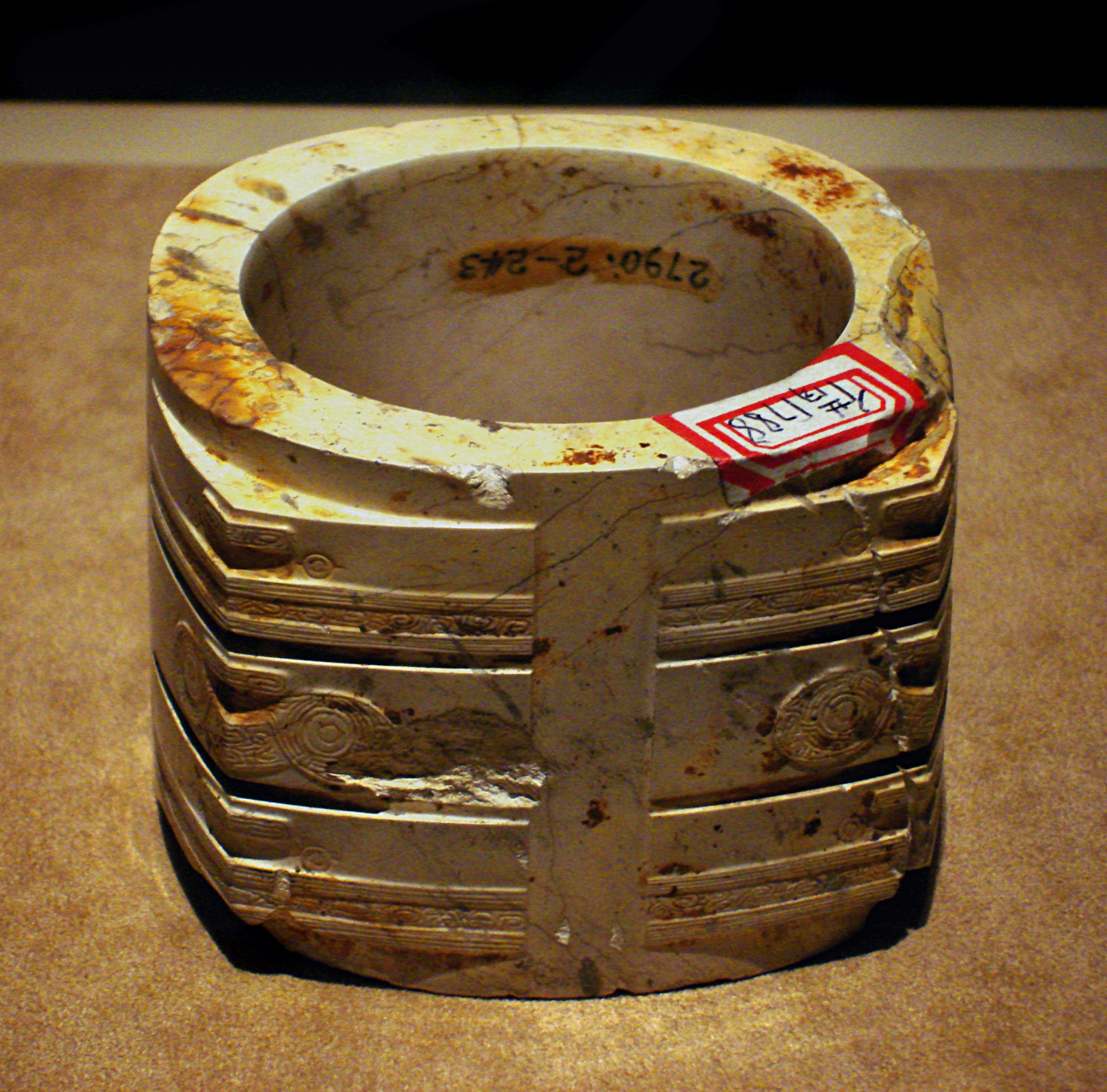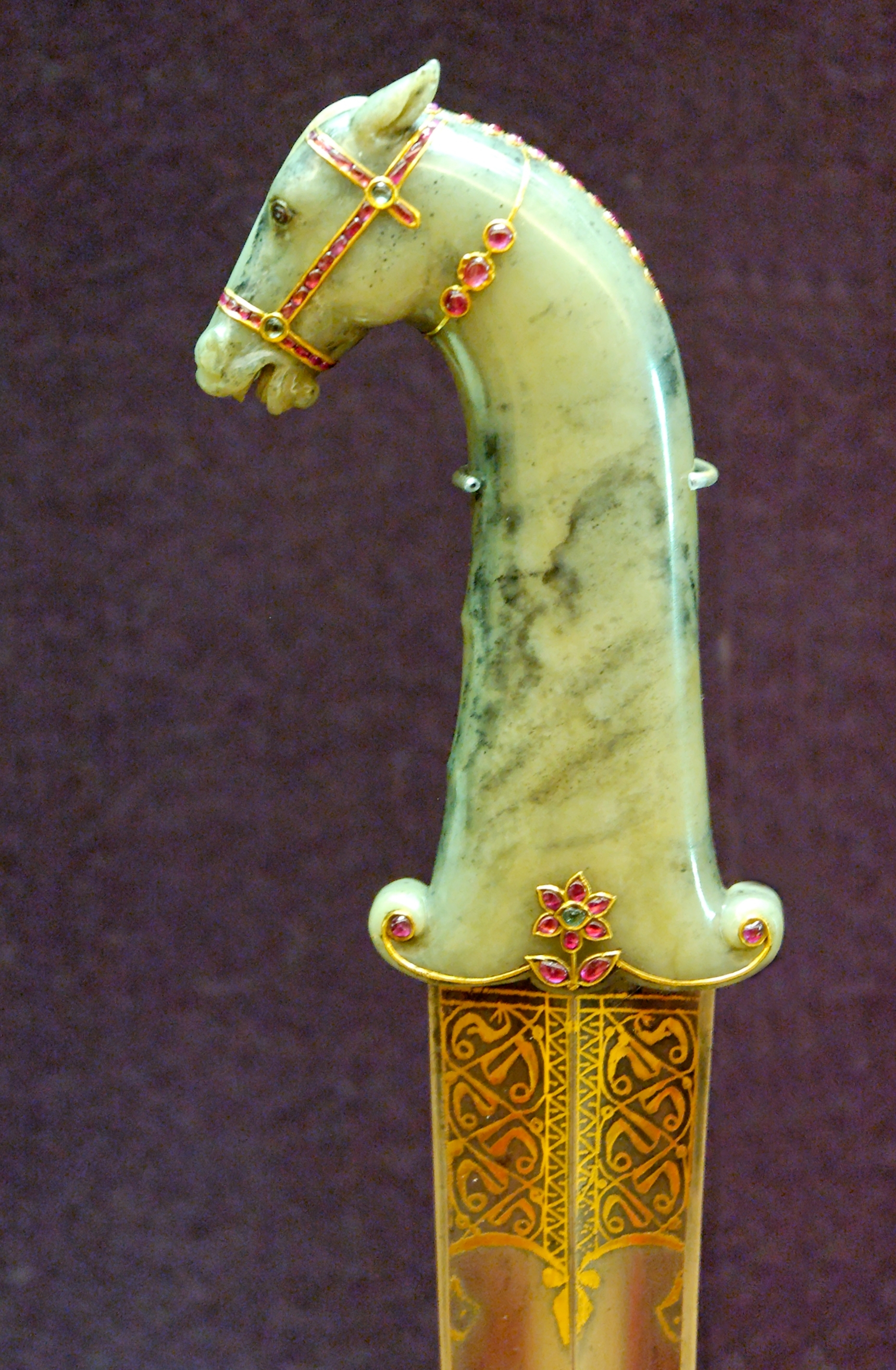|
Cong (vessel)
A ''cong'' () is a form of ancient Chinese jade artifact. It was later also used in ceramics. History The earliest ''cong'' were produced by the Liangzhu culture ( 3400- 2250 BC); later examples date mainly from the Shang and Zhou dynasties. Interest in the jade shape developed during the 12th-13th century Song dynasty. The shape continued to be used in ceramic and metalwork for centuries.BBC TV documentary: ''China in Six Easy Pieces'' (2013) presented by Lars Tharp http://www.bbc.co.uk/programmes/b036r5cx Description A ''cong'' is a straight tube with a circular bore and square outer section with more or less convex sides. The outer surface is divided vertically or horizontally such that the whole defines a hollow cylinder embedded in a partial rectangular block. Proportions vary: a ''cong'' may be squat or taller than it is wide. The outer faces are sometimes decorated with mask-like faces, which may be related to the ''taotie'' designs found on later bronze vesse ... [...More Info...] [...Related Items...] OR: [Wikipedia] [Google] [Baidu] |
:Category:Chinese Words And Phrases
This category is for articles on words and phrases of Chinese Chinese can refer to: * Something related to China * Chinese people, people of Chinese nationality, citizenship, and/or ethnicity **''Zhonghua minzu'', the supra-ethnic concept of the Chinese nation ** List of ethnic groups in China, people of va ... origin. For articles on words and phrases related to a specific area of China, or to a specific spoken variant, please refer to one of the subcategories. Words Words and phrases by language {{CatAutoTOC ... [...More Info...] [...Related Items...] OR: [Wikipedia] [Google] [Baidu] |
Song Dynasty
The Song dynasty (; ; 960–1279) was an imperial dynasty of China that began in 960 and lasted until 1279. The dynasty was founded by Emperor Taizu of Song following his usurpation of the throne of the Later Zhou. The Song conquered the rest of the Ten Kingdoms, ending the Five Dynasties and Ten Kingdoms period. The Song often came into conflict with the contemporaneous Liao, Western Xia and Jin dynasties in northern China. After retreating to southern China, the Song was eventually conquered by the Mongol-led Yuan dynasty. The dynasty is divided into two periods: Northern Song and Southern Song. During the Northern Song (; 960–1127), the capital was in the northern city of Bianjing (now Kaifeng) and the dynasty controlled most of what is now Eastern China. The Southern Song (; 1127–1279) refers to the period after the Song lost control of its northern half to the Jurchen-led Jin dynasty in the Jin–Song Wars. At that time, the Song court retreated south of the ... [...More Info...] [...Related Items...] OR: [Wikipedia] [Google] [Baidu] |
Hardstone Carving
Hardstone carving is a general term in art history and archaeology for the artistic carving of predominantly semi-precious stones (but also of gemstones), such as jade, rock crystal (clear quartz), agate, onyx, jasper, serpentinite, or carnelian, and for an object made in this way. Normally the objects are small, and the category overlaps with both jewellery and sculpture. Hardstone carving is sometimes referred to by the Italian term ''pietre dure''; however, ''pietra dura'' (with an "a") is the common term used for stone inlay work, which causes some confusion. From the Neolithic period until about the 19th century such objects were among the most highly prized in a wide variety of cultures, often attributed special powers or religious significance, but today coverage in non-specialist art history tends to be relegated to a catch-all decorative arts or "minor arts" category. The types of objects carved have included those with ritual or religious purposes, engraved gems as signet ... [...More Info...] [...Related Items...] OR: [Wikipedia] [Google] [Baidu] |
Chinese Pottery
Chinese ceramics show a continuous development since pre-dynastic times and are one of the most significant forms of Chinese art and ceramics globally. The first pottery was made during the Palaeolithic era. Chinese ceramics range from construction materials such as bricks and tiles, to hand-built pottery vessels fired in bonfires or kilns, to the sophisticated Chinese porcelain wares made for the imperial court and for export. Porcelain was a Chinese invention and is so identified with China that it is still called "china" in everyday English usage. Most later Chinese ceramics, even of the finest quality, were made on an industrial scale, thus few names of individual potters were recorded. Many of the most important kiln workshops were owned by or reserved for the emperor, and large quantities of Chinese export porcelain were exported as diplomatic gifts or for trade from an early date, initially to East Asia and the Islamic world, and then from around the 16th century to Eur ... [...More Info...] [...Related Items...] OR: [Wikipedia] [Google] [Baidu] |
Chinese Porcelain
Chinese ceramics show a continuous development since pre-dynastic times and are one of the most significant forms of Chinese art and ceramics globally. The first pottery was made during the Palaeolithic era. Chinese ceramics range from construction materials such as bricks and tiles, to hand-built pottery vessels fired in bonfires or kilns, to the sophisticated Chinese porcelain wares made for the imperial court and for export. Porcelain was a Chinese invention and is so identified with China that it is still called "china" in everyday English usage. Most later Chinese ceramics, even of the finest quality, were made on an industrial scale, thus few names of individual potters were recorded. Many of the most important kiln workshops were owned by or reserved for the emperor, and large quantities of Chinese export porcelain were exported as diplomatic gifts or for trade from an early date, initially to East Asia and the Islamic world, and then from around the 16th century to Eur ... [...More Info...] [...Related Items...] OR: [Wikipedia] [Google] [Baidu] |
Archaeological Artefact Types
Archaeology or archeology is the scientific study of human activity through the recovery and analysis of material culture. The archaeological record consists of artifacts, architecture, biofacts or ecofacts, sites, and cultural landscapes. Archaeology can be considered both a social science and a branch of the humanities. It is usually considered an independent academic discipline, but may also be classified as part of anthropology (in North America – the four-field approach), history or geography. Archaeologists study human prehistory and history, from the development of the first stone tools at Lomekwi in East Africa 3.3 million years ago up until recent decades. Archaeology is distinct from palaeontology, which is the study of fossil remains. Archaeology is particularly important for learning about prehistoric societies, for which, by definition, there are no written records. Prehistory includes over 99% of the human past, from the Paleolithic until the advent o ... [...More Info...] [...Related Items...] OR: [Wikipedia] [Google] [Baidu] |
Archaeological Artifacts Of China
Archaeology or archeology is the scientific study of human activity through the recovery and analysis of material culture. The archaeological record consists of artifacts, architecture, biofacts or ecofacts, sites, and cultural landscapes. Archaeology can be considered both a social science and a branch of the humanities. It is usually considered an independent academic discipline, but may also be classified as part of anthropology (in North America – the four-field approach), history or geography. Archaeologists study human prehistory and history, from the development of the first stone tools at Lomekwi in East Africa 3.3 million years ago up until recent decades. Archaeology is distinct from palaeontology, which is the study of fossil remains. Archaeology is particularly important for learning about prehistoric societies, for which, by definition, there are no written records. Prehistory includes over 99% of the human past, from the Paleolithic until the adve ... [...More Info...] [...Related Items...] OR: [Wikipedia] [Google] [Baidu] |
Bi (jade)
The ''bi'' is a type of circular ancient Chinese jade artifact. The earliest ''bi'' were produced in the Neolithic period, particularly by the Liangzhu culture ( 3400– 2250 BCE).Teaching Chinese Archaeology, object 3 - NGA Later examples date mainly from the , Zhou and dynasties. They were also made in |
Taotie
The ''Taotie'' () is an ancient Chinese mythological creature that was commonly emblazoned on bronze and other artifacts during the 1st millennium BC. ''Taotie'' are one of the " four evil creatures of the world". In Chinese classical texts such as the "Classic of Mountains and Seas", the fiend is named alongside the ''Hundun'' (), ''Qiongqi'' () and ''Taowu'' (). They are opposed by the Four Holy Creatures, the Azure Dragon, Vermilion Bird, White Tiger and Black Tortoise. The four fiends are also juxtaposed with the four benevolent animals which are Qilin (), Dragon (), Turtle () and Fenghuang (). The ''Taotie'' is often represented as a motif on '' dings'', which are Chinese ritual bronze vessels from the Shang (1766-1046 BCE) and Zhou dynasties (1046–256 BCE). The design typically consists of a zoomorphic mask, described as being frontal, bilaterally symmetrical, with a pair of raised eyes and typically no lower jaw area. Some argue that the design can be traced back ... [...More Info...] [...Related Items...] OR: [Wikipedia] [Google] [Baidu] |
Lars Tharp
Lars Broholm Tharp (born 27 March 1954, Copenhagen, Denmark)THARP, Lars Broholm , '' Who's Who 2011'', , 2011; online edn, , December 2010 (accessed 23 September 2011). is a -born British historian, lecturer and broadcaster, and one of the longest running 'experts' on the |
Zhou Dynasty
The Zhou dynasty ( ; Old Chinese ( B&S): *''tiw'') was a royal dynasty of China that followed the Shang dynasty. Having lasted 789 years, the Zhou dynasty was the longest dynastic regime in Chinese history. The military control of China by the royal house, surnamed Ji, lasted initially from 1046 until 771 BC for a period known as the Western Zhou, and the political sphere of influence it created continued well into the Eastern Zhou period for another 500 years. The establishment date of 1046 BC is supported by the Xia–Shang–Zhou Chronology Project and David Pankenier, but David Nivison and Edward L. Shaughnessy date the establishment to 1045 BC. During the Zhou dynasty, centralized power decreased throughout the Spring and Autumn period until the Warring States period in the last two centuries of the dynasty. In the latter period, the Zhou court had little control over its constituent states that were at war with each other until the Qin state consolidated power and forme ... [...More Info...] [...Related Items...] OR: [Wikipedia] [Google] [Baidu] |
CMOC Treasures Of Ancient China Exhibit - Jade Cong
{{disambiguation ...
CMOC may refer to: *Canadian Museum of Civilization, the former name of the Canadian Museum of History, a museum in Hull, Gatineau, Quebec *Cheyenne Mountain Operations Center *Civil-military operations center *Commodity Markets Oversight Coalition *Check Mii Out Channel for the Nintendo Wii The Wii ( ) is a home video game console developed and marketed by Nintendo. It was released on November 19, 2006, in North America and in December 2006 for most other regions of the world. It is Nintendo's fifth major home game console, f ... [...More Info...] [...Related Items...] OR: [Wikipedia] [Google] [Baidu] |



.jpg)


